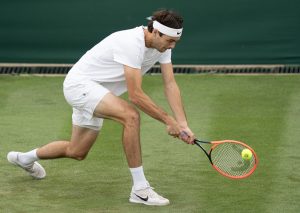Before Last Word on Tennis begins its series on “1968: The Year That Changed Tennis”, which commemorates the 50th anniversary of tennis going fully professional, our resident historian, Martin Keady, looks back at what the sport was like before it went Open.
Money is such an important part of 21st century sport (it is arguably the most important part) that it can sometimes seem inconceivable that people ever played games without being paid. And yet for most of the history of modern sport, which roughly began in the second half of the 19th century when a succession of former British public schoolboys codified most of the major sports that we know today, a lot of sport was essentially amateur. That was particularly true of tennis, which only became fully professional in 1968. Indeed, it is arguable that of all the major sports played today, it was tennis that experienced the most difficult transition from the old amateur game to the utterly professional, truly 21st-century sport that it is today.
Tennis has a long history, with early variants of the game reportedly being played as early as the 12th century AD, by monks using their hands to propel balls up and down monastery corridors. Rackets were only introduced in the 16th century and tennis reputedly became the first “sport of kings,” as only ruling monarchs were allowed to play on the type of indoor “real tennis” court that can be seen today at Hampton Court, outside London. Henry VIII was apparently a devotee of the game. Even more impressively, tennis is one of only two “sports,” as we understand the term today (rather than courtly activities such as jousting or falconry), that Shakespeare wrote about, making his Henry V hurl tennis balls at the French emissary who is foolish enough to present them as a gift to the King.
At the end of the 19th century, tennis ceased to be the sport of kings exclusively and instead became the sport of aristocrats and rich industrialists, as the sport came out of the cloisters and corridors and began to be played outside, on grass, or more specifically lawns. The growth in the sport’s popularity was confirmed by the creation of the Wimbledon Championships in 1877. And that growth was not confined to England. The spread of the game around the world can be traced in the starting dates of what remain the sport’s other “Major” championships: the US Open in 1881; the French Open in 1891; and the Australian Open in 1905.
Of course, the other three Majors were not “Open” at all for most of their history. Instead, they were simply “Championships,” just as Wimbledon has always been simply “The Championships.” That was because tennis largely remained close to its royal and aristocratic roots by remaining a strictly amateur sport for most of its existence.
The fundamental conflict between “amateurism” and “professionalism” in sport was between those who simply wanted to play a game (and could afford to do so) and those who needed (or just demanded) to be paid for their participation. That conflict existed, to a greater or lesser degree, in all the major sports that emerged from England at the end of the 19th century. The most conflict-ridden sport, in this sense, was rugby, which finally split into two different codes – amateur rugby union and professional rugby league – in 1895. That was because the largely working-class players from the north of England demanded “broken time” payments for the factory shifts they missed while playing, only for those demands to be dismissed by the largely southern-based administrators of the game. Even today, more than 20 years after rugby union itself finally went professional, rugby remains a riven sport, with two different codes that now appear irreconcilable.
Tennis did not suffer such an obvious rift within its ranks, largely because the sport continued to be played by relatively wealthy individuals who could afford to play without being paid. However, as tennis grew in popularity around the world and began to escape from its regal and aristocratic origins, the first steps on the path to true professionalism began to be taken.
Tennis really started to grow in popularity after World War One, when two of its greatest ever players – one man and one woman – were instrumental in its rapid ascent on both sides of the Atlantic Ocean. The man was America’s Bill Tilden, who was nicknamed “Big Bill” because of his then-considerable height. (In fact, he was only just over six feet tall, which would make him a relative minnow in today’s game, especially when compared with giants such as Ivo Karlovic and Juan-Martin del Potro.) In the 1920s, Tilden dominated the US Championships, as it was then called, winning six titles in a row beween 1920 and 1925 and winning one more for good measure in 1929, during which time he also won three Wimbledon titles and two French Championships. (As it was for so much of the 20th century, the geographically isolated Australian Championships was the runt of the “Major” litter and foreign stars like Tilden rarely competed in it.)
At almost exactly the same time, the first female superstar of tennis was also emerging. That was France’s Suzanne Lenglen, who in the late 1910s and early 1920s not only won two French Championships but an astonishing six Wimbledon women’s singles titles, including five in a row between 1919 and 1923.
Tilden and Lenglen became the first great global tennis stars, and such was their popularity that others inevitably attempted to cash in on it. The first successful attempt was the foundation of the first professional tennis tour, in the US in 1927, by Charles C. Pyle, an American arts and sports entrepreneur who had made his name in theatre before becoming an agent in American football, or gridiron. He then moved into tennis by becoming the agent for Suzanne Lenglen and persuading her to turn professional and play a series of high-profile exhibition matches, mostly against American women (thus cashing in on the popularity of tennis on both sides of the Atlantic).
Lenglen and a few other stars may have turned professional, but tennis itself did not. Instead, the sport’s ruling bodies responded to what they perceived as a threat to the very nature of tennis by banning from its showpiece events – the four Majors – anyone who, like Lenglen, had turned professional. And that ban would remain in place for more than 40 years.
Thus, tennis was split into two, between the amateur game and the professional sport. Typically, the game’s greatest players, such as Britain’s Fred Perry in the 1930s, would first make their name as an amateur (by winning one or more of the Majors) before turning professional to try and make the money that they had been denied as an amateur. However, competition on the “professional” circuit was relatively limited. In fact it was barely a “circuit” or “tour” at all, but rather a succession of high-profile exhibition matches, or even “series” of matches between the same players, that were largely played out in America.
As with so many things, tennis was finally transformed by the Sixties. In the post-war period, the two sides of tennis – the amateur Majors and the professional exhibition matches – had existed rather uneasily alongside each other, with only some overlap between the two. By the start of the 1960s, however, the effects of the game’s great divide began to be more pernicious, as many of the world’s greatest tennis players were being prevented from competing in the world’s greatest tennis tournaments, i.e. the four Majors. The most spectacular example of that was Rod Laver, the magnificent Australian player, who won a genuine calendar Grand Slam of all four Majors in 1962, as well as helping Australia to win the Davis Cup at the end of the year. However, Laver then turned professional, spending most of the rest of the 1960s playing exhibition matches and “professional” tournaments, mainly in the US.
It was only in 1968 that tennis finally became “Open,” or fully professional, thus allowing the game’s greatest players, like Laver, to return to the fold and the main tennis circuit. Ironically, this historic move was made as much to root out the so-called “shamateurism” that had taken hold in the game (whereby even supposedly amateur players received secret or illicit payments) as to embrace the benefits of allowing players to make their living from the sport. Nevertheless, regardless of the motivation for it, tennis had finally caught up with almost all the other major professional sports (most of which had gone professional right from the start, or soon afterwards) and became one unified, professional whole again.
There were inevitably teething problems (to say the least) as the new “Open” era began, with the three non-Wimbledon Majors changing their name to reflect the sport’s new status. Ultimately, however, it was the rebirth, or some would argue the actual birth, of the sport that we know today, which is undoubtedly the greatest individual sport in the world. (Boxing is hardly a sport at all and golf, frankly, is boring in comparison with tennis.) And if “Rocket Rod” Laver couldn’t quite mark the start of the new era with an immediate bang, by repeating his 1962 Grand Slam in the sport’s first year of full professionalism, he did so soon afterwards, by winning the first (and so far the last, at least on the men’s side) professional “Calendar Grand Slam” in 1969.
Others in this series
1968: The Year that Changed Tennis
1968 French Open
1968 Wimbledon
1968 US Open
Main Photo:
Embed from Getty Images






